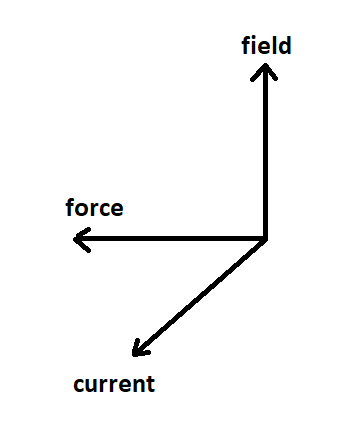
A beam of cathode rays moves from left to right in a plane of paper and it enters into a uniform magnetic field acting perpendicular to the plane of the paper and inwards. Now, the cathode rays are deflected:
(A) Downwards
(B) Upwards
(C) In a direction perpendicular to the plane of the paper and inwards
(D) In a direction perpendicular to the plane of the paper and outwards
Answer
512.7k+ views
Hint: In order to find the correct answer for the above question, we will be using the concept of the effect of the magnetic field on a moving charge. We will also use Fleming's left hand rule and the concept of Lorenz force.
Complete step by step answer:
First of all, whenever we talk about a charge moving with velocity in a particular direction, there is a magnetic field created and the direction of this magnetic field can be given with the help of the Right Hand Thumb Rule. Remember that a moving charge represents a current.
Now, if a charge is moving with a certain velocity in a particular direction in the effect of some magnetic field, then the particle experiences a force and the magnitude of this force is given by the Lorenz force equation and the force is said to be Lorenz force. The direction of this force can be determined by Fleming's left hand rule.

Fleming's left hand rule states that the direction of velocity, the direction of the magnetic field and the direction of force experienced due to this magnetic field are perpendicular to each other. In the figure, the thumb represents the direction of current, the first finger shows the direction of the magnetic field and lastly the second finger shows the direction of force experienced by the moving charges.
The main purpose of this solution is to find the direction of the force acting on the electrons present in the cathode ray. Simply using Fleming's left hand rule, we can conclude that the direction of the force experienced by the cathode ray charges will be in the upward direction and the ray will be deflected upwards.
Therefore, the correct answer is option (B).
Note:
Keep in mind that the name Fleming’s Left Hand Rule itself suggests that it should be performed with the help of the left hand and not the right hand. Cathode ray is a group of electrons which are emitted from cathode through various techniques and then concentrated into a beam.
Complete step by step answer:
First of all, whenever we talk about a charge moving with velocity in a particular direction, there is a magnetic field created and the direction of this magnetic field can be given with the help of the Right Hand Thumb Rule. Remember that a moving charge represents a current.
Now, if a charge is moving with a certain velocity in a particular direction in the effect of some magnetic field, then the particle experiences a force and the magnitude of this force is given by the Lorenz force equation and the force is said to be Lorenz force. The direction of this force can be determined by Fleming's left hand rule.

Fleming's left hand rule states that the direction of velocity, the direction of the magnetic field and the direction of force experienced due to this magnetic field are perpendicular to each other. In the figure, the thumb represents the direction of current, the first finger shows the direction of the magnetic field and lastly the second finger shows the direction of force experienced by the moving charges.
The main purpose of this solution is to find the direction of the force acting on the electrons present in the cathode ray. Simply using Fleming's left hand rule, we can conclude that the direction of the force experienced by the cathode ray charges will be in the upward direction and the ray will be deflected upwards.
Therefore, the correct answer is option (B).
Note:
Keep in mind that the name Fleming’s Left Hand Rule itself suggests that it should be performed with the help of the left hand and not the right hand. Cathode ray is a group of electrons which are emitted from cathode through various techniques and then concentrated into a beam.
Recently Updated Pages
A man running at a speed 5 ms is viewed in the side class 12 physics CBSE

The number of solutions in x in 02pi for which sqrt class 12 maths CBSE

State and explain Hardy Weinbergs Principle class 12 biology CBSE

Write any two methods of preparation of phenol Give class 12 chemistry CBSE

Which of the following statements is wrong a Amnion class 12 biology CBSE

Differentiate between action potential and resting class 12 biology CBSE

Trending doubts
What are the major means of transport Explain each class 12 social science CBSE

Which are the Top 10 Largest Countries of the World?

Draw a labelled sketch of the human eye class 12 physics CBSE

Explain sex determination in humans with line diag class 12 biology CBSE

Explain sex determination in humans with the help of class 12 biology CBSE

Differentiate between homogeneous and heterogeneous class 12 chemistry CBSE




